GyeongGi Cultural Foundation
Suwon_The past and present of Suwon Station (1)
As a province adjacent to Seoul, the country's capital city, Gyeonggi-do has inherited a vast amount of Korea's modern cultural heritage as the country has undergone a turbulent modern history, ranging from the latter part of the Joseon Dynasty to the Japanese Occupation Period followed by the national liberation and division, the Korean War, and the impressive industrialization and democratization processes. “Modern Cultural Heritage of Gyeonggi” will feature an introduction to the modern culture of Gyeonggi-do together with a discussion about the history, identity and values of the Province in terms of cultural heritage. |
Writer | Ho-jin Choi
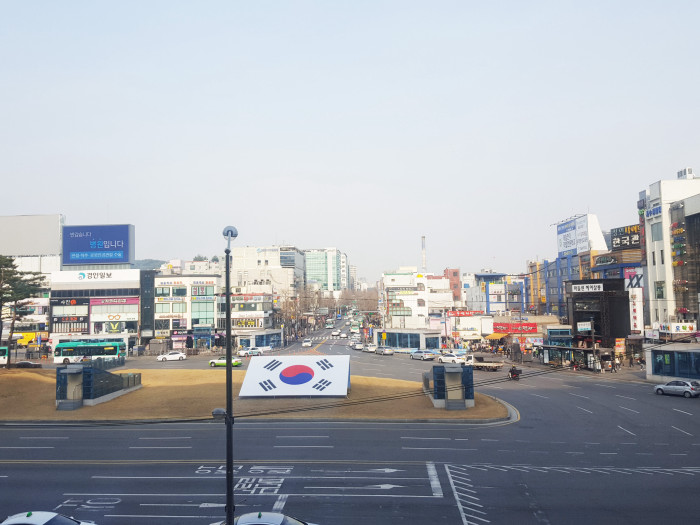
How would the recent past look for Suwon, Gyeonggi-do? If you get off at this large privately-funded station, you will see the busy neighborhood crowded with vehicles and go to your destination via an underpass. Suwon became the seat of the Gyeonggi Provincial Government in 1896, and was raised in status to Suwon-si in 1949. The modern history of Suwon is closely related to the history of rail transport. Although Hwaseong Fortress, Suwon was the center of daily life, the neighborhood of Suwon Station has now become the center of commerce and transportation. I decided to look for the recent past of Suwon here.
History of rail transport and Suwon Station
The history of Korean rail transport began when the 33.2 kilometer Noryangjin-Jemulpo section of the Gyeongin Line was temporarily opened on September 18, 1899. In the late 19th century, the Korean government, which was pursuing a civilization policy, tried to construct a railway using national capital. However, it faced difficulties due to poor financial conditions. As a result, the Korean government handed over rights of construction of the Gyeongin Line to James R. Morse, an American businessman, in March 1896. Although Morse commenced the construction of the Gyeongin Line in 1897, he was unable to complete the work due to lack of funds, and sold his rights of railway construction to Japan in 1898. Consequently, the Korean railroad was opened by Japan on September 18, 1899.
After the Gyeongin Line had been constructed in 1899, the Gyeongbu Line, Gyeongui Line, Honam Line and Gyeongwon Line, Janghang Line, and Jungang Line were opened in 1905, 1906, 1914, 1931, and 1942, respectively. However, the railways were later divided into south and north when the Korean Peninsula was divided following the liberation of Korea and the Korean War.
Suwon Station, situated between Hwaseo Station and Seryu Station, serves the Gyeongbu Line and the Seoul Metro. When the Gyeongbu Line was opened on January 1, 1905, Suwon Station started operation as a normal railway station. The Suyeo Line (Suwon~Yeoju) was opened on December 1, 1930, and the Suin Line (Suwon~Incheon) started operation on August 6, 1937. The railway station of the Gyeongbu Line was a hanok-style building in the very beginning. After the liberation of Korea and the Korean War, this station was torn down in 1961 when a new station building was constructed.
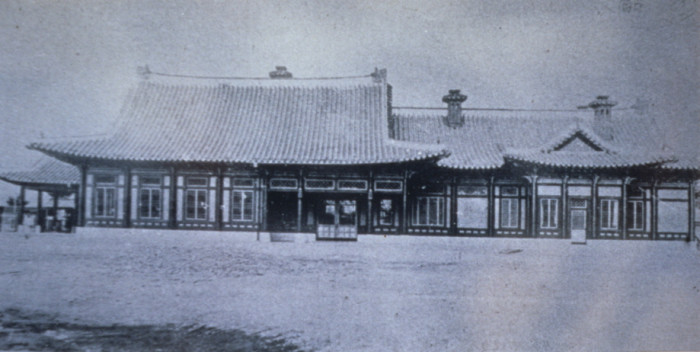
Suwon Station in the 1920s
The Suyeo Line was shut down on March 31, 1972, and the Seoul-Suwon section of the Seoul Metro started operation on August 15, 1974. When a subway station building was opened on December 31, 1975, Suwon Station began service for the Seoul Metro and Gyeongbu Line (Saemaeul-ho and Mugunghwa-ho). On January 1, 1996, the Suin Line stopped operation, and narrow-gauge railway stations were closed. In February 2003, the construction of privately funded Suwon Station was completed, which is the current station building. The Seoul Metro (Suwon~Byeongjeom) was extended on April 30, 2003 and the Mangpo-Suwon section of the Bundang Line was fully opened on November 30, 2013. In 2018, the Bundang Line and Suin Line will be directly linked and the section from Wangsimni Station to Incheon Station will be operated as one line.
In addition to Suwon Station of Gyeongbu Line, the Suyeo Line and Suin Line were important railways in Suwon. The Suin Line is a 57 kilometer narrow-gauge railway connecting from Songdo of Incheon to Suwon. The Suin Line was originally planned for transport of salt from the salt ponds of Sorae, Namdong, and Gunja of the Gyeonggiman Bay. Its construction commenced on September 23, 1935, and was completed on August 6, 1937 as a privately owned railway of the Chosen Gyeongdong Railway. After the liberation of Korea, it was nationalized. The Suin Line connected the Suyeo Line (Suwon-Yeoju section, shut down in 1972) to Incheonhang Port during the Japanese Colonial Era. As the volume of salt and the needs for transport convenience increased after the 1970s, the number of passengers and the volume of freight reduced and its economic feasibility greatly decreased. Namincheon Station, which was the last stop, was closed in November 1973, and cargo transport was stopped in 1977. In 1995, passenger transport was stopped as well, and the Suin Line was shut down.
Some sections of the Suin Line were remodeled into Suin Line Park. You can still see remnants of the Suin Line and Suyeo Line in aerial and other photographs. When the Suin Line was in operation, many people visited Songdo for picnics. When a narrow-gauge train went from Suwon Station to Incheon, it slowed down to pass the highly curved track. It is said that many students got on the moving train there to go to school.
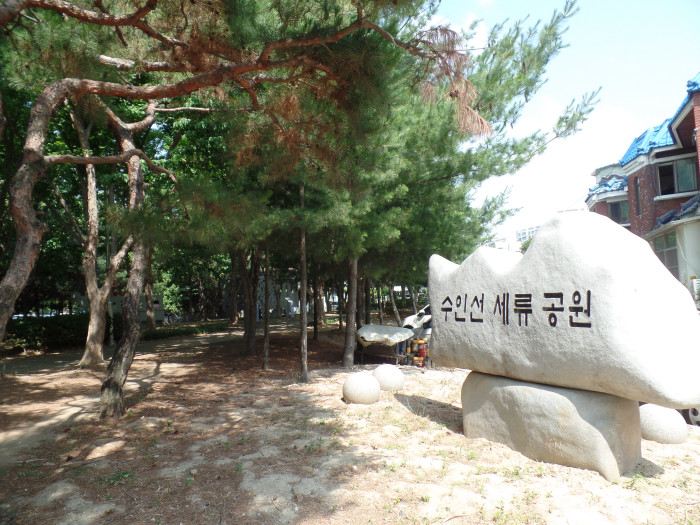
Suin Line Seryu Park
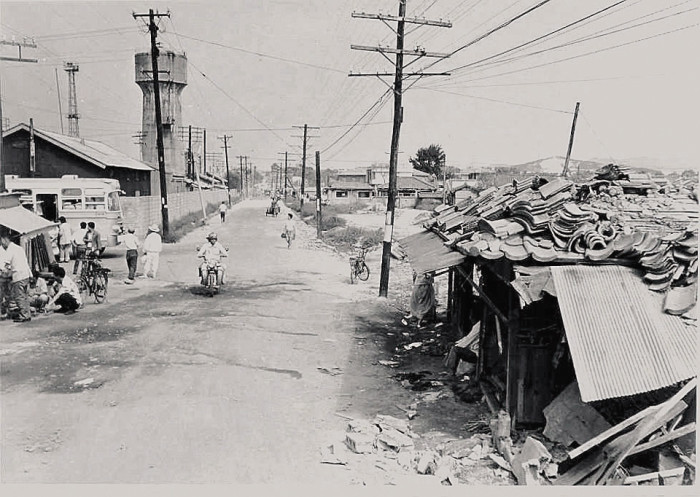
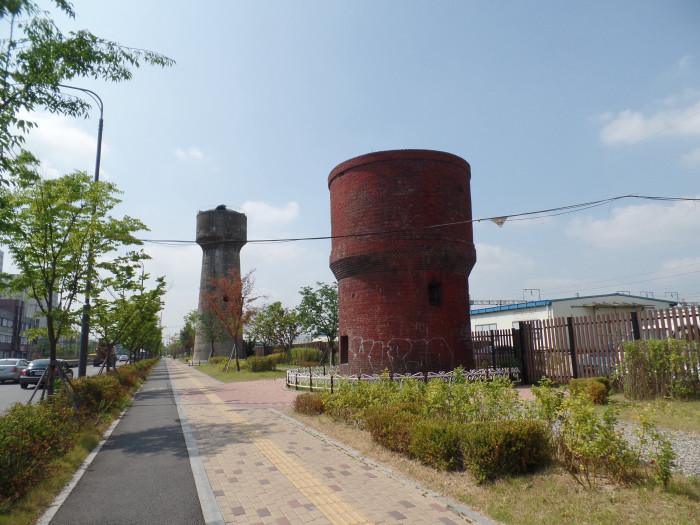
<Copyright(c)2002 GGC All rights reserved.>
information
Modern Cultural Heritage in Gyeonggi-do
Writer/ Ho-jin Choi , Head of Jium Urban Architecture Lab
Reference/ Railway Industry Information Center, History of Suwon, and Suwon
- Writer
- GyeongGi Cultural Foundation
- About
- Everything about the GyeongGi arts and culture, GGCF
- homepage
- https://www.ggcf.kr/